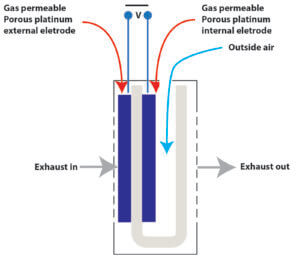How an Oxygen sensor works
Learn how an oxygen sensor works
An oxygen sensor measures how much oxygen is left in the exhaust after combustion. The vehicle’s Engine Control Module (ECM) uses that data to recalculate how much fuel to add to each cylinder. There are two types of sensors, narrow band and wide band; also = known as an O2 sensor or an air fuel ratio sensor. I’ll explain how an oxygen sensor works and compare it to how an air fuel ratio sensor works.
Oxygen levels in the exhaust are always changing
If the engine were just running with a set load and a set speed, you wouldn’t need an oxygen sensor. You could adjust the air/fuel ratio to get a good burn and stay within emissions standards. But those conditions never exist when driving a vehicle. The driver is always pressing or releasing the gas pedal and the vehicle is always encountering hills or valleys. So, the ECM must constantly change how much fuel it adds to the incoming air. It uses the oxygen sensor to see how accurate its air-fuel calculations are and to adjust them for a better burn.
How an oxygen sensor works
When you start a cold engine, the computer calculates air/fuel based on engine temperature, ambient air temperature, and MAF/MAP sensor readings. The oxygen sensor must heat up to approximately 600°F before it can accurately measure oxygen in the exhaust. Carmakers add a heater to the oxygen sensor to help it heat up faster. Once the engine coolant temperature reaches a set temp and the oxygen sensor heater heats up the oxygen sensor, the computer starts calculating air/fuel based on the oxygen sensor feedback.
The oxygen sensor monitors the exhaust and reports back to the computer approximately 100 times per second. That helps the computer reduce or increase fuel as needed to maintain vehicle speed and load.
Narrowband oxygen sensors
These sensors are made with a zirconia  thimble that produces a voltage that’s directly proportional to the amount of oxygen in the exhaust. It’s made from a ceramic cylinder with a porous platinum-plated electrode on the inside of the cylinder and another electrode on the outside of the cylinder. Outside air enters the inside of the cylinder, and exhaust is exposed to the outside electrode.
thimble that produces a voltage that’s directly proportional to the amount of oxygen in the exhaust. It’s made from a ceramic cylinder with a porous platinum-plated electrode on the inside of the cylinder and another electrode on the outside of the cylinder. Outside air enters the inside of the cylinder, and exhaust is exposed to the outside electrode.
When the exhaust mixture is too rich, there are fewer oxygen ions in the exhaust and more oxygen ions in the outside air. Exhaust oxygen ions are negatively charged, so the oxygen sensor will generate a very low or no voltage. In a lean exhaust condition with too little fuel in the combustion chamber, the exhaust will contain more oxygen ions. Those will pass through the electrodes and create up to 1 volt of power.
The lifespan of the narrowband oxygen sensor
Typical narrowband oxygen has a lifespan of about 100,000 miles. Oxygen sensors can be damaged by excessive oil, coolant, or silicon from RTV sealants. Contrary to popular belief, oxygen sensors cannot be cleaned. You can apply a cleaner and they may look clean. But in reality, once a sensor is contaminated by oil, coolant, or silicone, it is permanently damaged and must be replaced.
In effect, a narrowband oxygen sensor constantly swings between rich and lean (0-volts and 1-volt) with 0.45-volts being a perfect air/fuel mixture.
Wideband oxygen sensors
A wideband oxygen sensor works differently. First, to operate properly, wideband oxygen sensors must reach temps of 1,292°F to 1,472°F to operate properly. Like narrowband sensors, wideband sensors also have a heater to help the sensor reach those temps faster and maintain that temperature.
A wideband oxygen sensor heater consumes about 8 amps and is usually pulse width modulated by the PCM to vary the amount of heat needed to keep it at operating temperature. So a wideband sensor will use more power when the engine is cold than when hot. If the heater fails to keep the sensor at temperature, the PCM will set a P0125 trouble code. If you see that code, first check the fuse to the sensor heater.
How a wideband oxygen sensor works
Instead of reporting rapid voltage swings, it provides a gradual current change that can be positive or negative. The signal gradually moves to a positive value when the exhaust is lean. When the exhaust is stoichiometric (14.7:1), the current flow stops. As the exhaust becomes rich, the current becomes negative.
The PCM supplies the wideband sensor with a reference voltage (usually 3.3 volts or 2.6 volts) through two wires. The sensor then alters the reference voltage based on the exhaust oxygen content and sends its results through a separate pair of wires to the PCM. If the return signal is less than the reference voltage, the sensor reports a rich condition. If the signal is above the reference voltage, the sensor reports a lean condition.
©, 2021 Rick Muscoplat
Posted on by Rick Muscoplat
